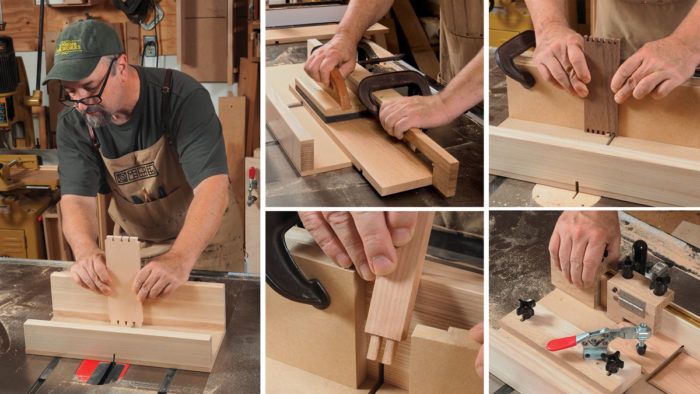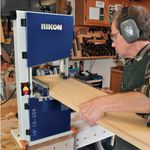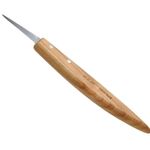Table saw sleds for joinery
Mike Pekovich has a sled for each job: a sled for cutting dovetails, one with a sliding fence for box joints, a sled with a lower fence and stops for cutting dadoes, one with a tall fence for cutting tenons, and a dedicated sled for mitered boxes.

Synopsis: Shopmade crosscut sleds come in handy when traveling and also around the shop. Using miter gauges as runners, Mike Pekovich has a sled for each job: a sled for cutting dovetails; one with a sliding fence for box joints, a sled with a lower fence and stops for cutting dadoes, one with a tall fence for cutting tenons, and a dedicated sled for mitered boxes. They are easy to make and store out of the way when not being used.
I’ve always considered making a crosscut sled a big undertaking. I worked hard to get mine as accurate as possible and then I tried to hang onto it as long as I could. My current go-to sled has been around for a couple of years now and the surface and fence have been patched up a number of times due to the odd dado or miter that I needed to cut.
However, when I began to travel more to teach, I would often put together a quick sled from scraps and use a pair of miter gauges as runners. The miter gauges allowed me to fit the sled to saws with varying miter slot spacings, but they also did away with the fussy chore of mounting runners. Of course once I had them around the shop, I tended to use them quite a bit.
While my everyday sled is still great for crosscuts, I use the others for specific joinery jobs—such as cutting dadoes, miters, tenons, or dovetails—those that require a wider blade or one tilted at an angle. Luckily, these tasks don’t require big sleds, so it’s easy to keep a number of them stacked in a corner and ready to go when I need one.

Size the sled to the task
For jobs where the stock is positioned vertically, such as dovetailing, tenoning, and cutting box joints, the depth of the sled can be minimal, but a higher fence will serve you well. Conversely, a sled for dadoes may need to be deeper depending on the width of your workpieces. The sled for mitered boxes is wider in order to support the offcut.
For the base, I use 1⁄2-in.-thick MDF or Baltic-birch plywood. A stable hardwood is nice for the fences, and I often glue up scraps to make them. I glue and screw the fence to the base, keeping the fasteners clear of the cutting area.
For most of my joinery sleds, I screw the miter gauges directly to the fence. On my box-mitering sled they bolt to a T-track, which I’ll explain later. Either way, if you check to make sure that the miter gauges are square to the blade, once you attach them to the sled, it should be square as well.

From Fine Woodworking #286
To view the entire article, please click the View PDF button below.
 |
|
 |
|
 |
Fine Woodworking Recommended Products

Rikon 10-3061 10-in. Deluxe Bandsaw
The saw has two speeds: 3,280 sfpm (surface feet per minute) for wood and 1,515 sfpm for soft metals and some plastics.

Pfiel Chip Carving Knife

Ridgid R4331 Planer








Comments
This article is fantastic. Mike has such a clear and unpretentious way of explaining things. Thank y’all for sharing this.
always great stuff. Are we likely to see sleds and things for slider saws? they have many of the features you aim for in but but still... box making or other jigs might be nice to see.
Mike, speaking for myself you are an inspiration to be a better woodworker. And you have a real talent for teaching. It ALL sinks in when you give a lesson. Thanks.
Always enjoy your presentations Mike. I'll probably build the miter sled, but need help with a related process - Getting the blade to an exact 45-degree angle. Do you have a process or tips for that?
Log in or create an account to post a comment.
Sign up Log in